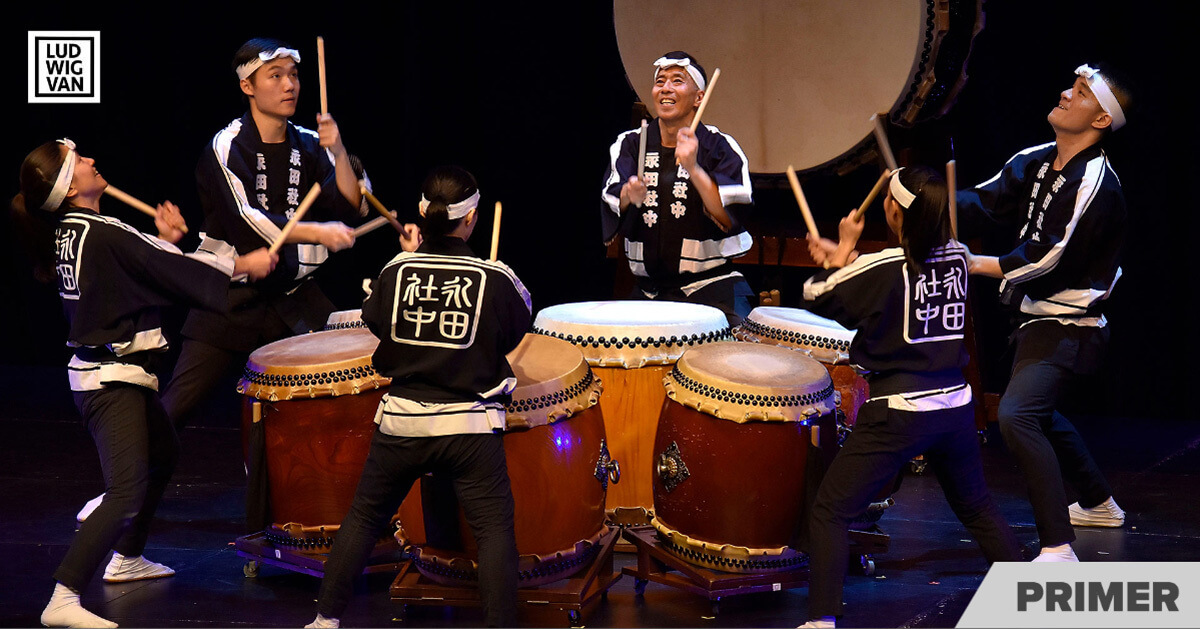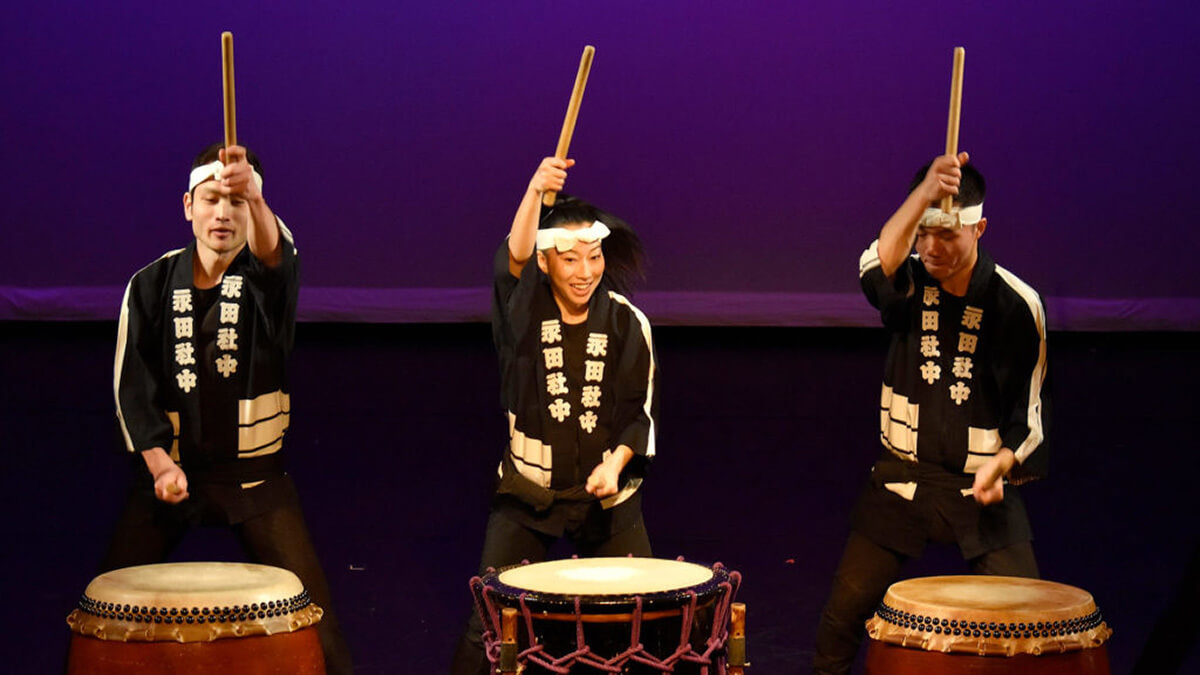
Presented by Esprit Orchestra
Many Esprit fans will recall the bone-chilling ice storm that brought Toronto to a standstill on April 15, 2018. That wintry blast also prevented dozens of audience members from getting to Koerner Hall to hear Taiko drum group Nagata Shachu raise the roof with the Canadian premiere of Maki Ishii’s Mono-Prism.
Fast forward nearly two years later and the seven-piece ensemble helmed by founding artistic director Kiyoshi Nagata returns for an encore performance of the thundering work composed in 1976 for Japanese drums and orchestra, that promises to enthrall listeners with its heart-pounding rhythms and dazzling East-meets-West ethos.
“A lot of people wanted to hear this work in 2018 but were stuck at home because of the ice storm. And the audience that was there wanted to hear it again because of the fantastic artistic nature of the work, performed by fantastic artists,” Alex Pauk, Esprit Orchestra conductor and founder reveals over the phone. “It’s also a clear encounter of musical poetics between Eastern and Western traditions that creates a special kind of musical reverberation, with an intoxicating energy that builds to a feverish excitement where the drummers are almost in a trance at times, embraced by the orchestra and its interjections. It’s a thrilling piece and deserves to be heard again.”
Taiko drums were traditionally used to communicate with the gods, with a variety of sizes ranging from the smaller, higher-pitched “Shime” drums, to the powerfully dramatic, massive “O-Daiko” drums struck by two players at opposite ends. A battery of Japanese drums will be used in Mono-Prism, titled for the monochromatic tones of the instruments, while prism reflects the rainbow hues of orchestral colours and timbres that underpin the smaller ensemble.
But listeners expecting only a loud ‘n’ proud performance will be surprised to hear the quieter, more sensitive voices of the drums, including the piece’s breathless opening that ultimately builds to a crashing crescendo.
During its central section, players also tap out intricate rhythms with tapered sticks that evokes sounds of falling raindrops or gentle winds — demanding utmost precision and control by the musicians trained to learn Taiko music not by memorizing a score, but via the oral tradition, and sans conductor.
And then — of course — there are other moments described by Nagata as, “structured chaos,” in which the players perform interlocking rhythms freely among each other that further gets the blood pumping.

“Playing Taiko drums is a combination of all three physical, mental and spiritual aspects,” Nagata explains. “In order to create a big sound, you need to play with a lot of power, a lot of muscle, and a lot of strength. But you also need to play mindfully and with purpose so you would never just hit the drum for the sake of it. There’s also a belief that within every drum a spirit or a God exists, so you play with a lot of respect,” he adds.
“Audience members will be amazed by all the different kinds of sounds from Japanese drums that they’ve never heard before with this piece,” says Nagata, who met the renowned late composer in Japan while apprenticing with a local drum group nearly 30 years ago. “The audience should prepare to come to the concert with open ears, expect the unexpected, and be awed.”
The eclectic program described by Pauk as a “very sophisticated, diverse and complex concert,” also features Barbara Croall’s Mijidwewinan (Messages) written in 2008 for Anishinaabekwe soloist and orchestra. The work notably showcases the artist, who is Odawa First Nations in her Esprit debut as a performer, with her violin concerto The Four Directions heard during a prior EO concert.
“Barbara brings her Indigenous culture into the framework of the orchestral world and is also an exceptional performer,” Pauk says of the piece that seamlessly blends Odawa vocal and flute tradition with a Western sensibility. “The piece is a cry or calling out to take care of the natural environment, with references to the teachings of indigenous elders in relation to the elements of nature, including the animals and birds and the early morning star and times of the day,” he adds of the deeply spiritual piece that suggests visionary messages being received from ancestors and elders.
“There’s a transcendental aspect to Barbara’s performance, as if she’s entering another spirit world,” the conductor shares. “By the end, she’s nearly bursting from despair but the message is not one of gloom, but of moving that despair forward while reflecting on all of the wonderful things there are around us.”
Listeners will also be treated to two world premieres: Christopher Goddard’s Piano Concerto and Eugene Astapov’s A Still Life, based on Russian writer Polina Barskova’s poetry, and featuring JUNO award-winning Canadian soprano Shannon Mercer.
“A policy I’ve been developing more intensely lately is to work with composers in successive years to help them develop their craft and ensure that they’ll have fine performances of their work,” Pauk affirms. “Chris’s piano concerto is a monster work with an incredibly difficult piano part that he’s written for himself to play as soloist in this premiere.”
He also sings praises for Astapov, another artist being nurtured through Esprit’s Creative Sparks mentoring project, as well as the annual New Wave Composers Festival for emerging composers.
“I asked Eugene to create something that’s close to his heart and it’s also close to his culture and Russian background,” he says of the premiere being conducted by Astapov himself.
“Our final concert is extra special in that there’s quite a range of diverse elements that you would not normally experience, with each piece reflecting an artist’s cultural heritage or compositional evolution,” Pauk says. “There’s a real purity and strength in that, with each piece demanding that the audience goes to these really interesting places.”
[Update: March 13, 2020. Due to the concerns with the coronavirus, this event has been postponed until the fall of 2020.]
- GUIDE | Ontario Summer Music Festivals 2022 - July 1, 2022
- INTERVIEW | Sheku Kanneh-Mason On Reuniting With Family For Toronto Debut - May 2, 2022
- FEATURE | How The Royal Conservatory Avoided A Disaster - June 9, 2021



